| “ | Often, after I had killed, I pleaded to be put away in a military asylum, but not a madhouse. If [Hans] Grans had really loved me he would have been able to save me. Believe me, I'm not ill — it's only that I occasionally have funny turns. I want to be beheaded. It'll only take a moment, then I'll be at peace. | ” |
— Haarmann
| ||
Friedrich Heinrich Karl "Fritz" Haarmann, also known as "The Butcher of Hanover" or "The Vampire of Hanover", was a prolific German pedophilic con artist-turned-"vampirist"-type serial killer and cannibal (and possible projected cannibal) responsible for over two-dozen murders of young males.
Background[]
Born in Hanover on October 25, 1879, during the German Empire, Haarmann was the sixth child of a poor couple, Ollie and Johanna. He was motivated by his sickly mother to play with his sisters' dolls instead of boys' activities. As a result, Haarmann seemed to have a bit of a feminine personality; he also had sadistic tendencies in which he would tie up his sisters and also tap windows during the nighttime to cause rumors of supernatural creatures that roam about in the middle of the night. He also harbored a dislike for his father, whom he would threaten to throw in jail as Ollie supposedly murdered a train driver. Performing terribly in school, Haarmann was sent to attend a military academy at Neu Breisach. Though he did well, Haarmann was eventually discharged for medical reasons after having a series of seizures. Returning to Hanover, he found employment at a local cigar factory. Sometime in 1898, he was arrested for molesting several children but was deemed psychologically unfit to stand trial and was sentenced to a mental institution. Six months into his stay, Haarmann escaped and sought shelter in Switzerland before returning to Germany at the age of 20. Around 1900, he was able to seduce and marry a woman named Erna Loewert, later impregnating her with their child. Haarmann then abandoned Loewert in favor of a life in the military.
Becoming a soldier, Haarmann, much like the serial killer William Burke, led a successful life under the occupation. However, on October of 1901, all of that abruptly ended when he collapsed during an exercise and was diagnosed as having an unspecified mental deficiency. As a result, he was discharged and sent back to live with his family. His father made at least one attempt at putting Haarmann in an asylum, but the local doctors merely deemed him as "morally inferior". Haarmann attempted to open up a small business of his own, but it went bankrupt immediately and was closed down. Sometime after this, he started a series of petty burglaries and con jobs to easily gain money and spent about one-third of the following two decades being incarcerated for such crimes. Because of his frequent arrests, he became well-known with the Hanover police, even becoming one of their informers after his latest release in 1918, just to redirect police attention from himself. Simultaneously, World War I began and he was hit hard by the inflicted national poverty. Haarmann also started a number of misdemeanor sexual offenses that went unnoticed by authorities mostly because his partners were too ashamed to file reports.
Killings, Arrest, and Execution[]
"I never intended to hurt those youngsters, but I knew that if I got going something would happen and that made me cry... I would throw myself on top of those boys and bite through the Adam's apple, throttling them at the same time."
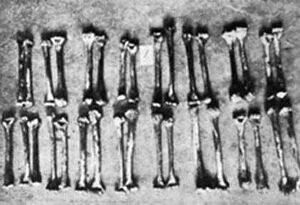
Some of the many bones of Haarmann's victims that were recovered from the Leine River.
Finally, Haarmann suddenly snapped and murdered a 17-year-old youth named Friedel Rothe on September 25, 1918. Following from eyewitness accounts provided by Rothe's friends and the pressure from Rothe's family, authorities raided Haarmann's residence and found him with a teenage boy in bed, having been seduced by him for about nine months. Haarmann was arrested for sexual assault, but the police, for some unknown reason, never searched his house and, as a result, he was cleared of any suspicion of Rothe's murder. Eventually released, Haarmann later met Hans Grans (see the below section) at the Hanover central station, and the two became fast friends and, eventually, homosexual lovers. In early 1922, they moved to an apartment, number 27 Cellerstraße, which was located in the "haunted area" of Hanover. Haarmann then started murdering young men again, this time by luring them in by pretending to be a police officer. Grans became his accomplice after unexpectedly returning home to witness Haarmann murder his second victim, 17-year-old Fritz Franke. In the following nine months, twelve men were murdered this way, with their dismembered remains being dumped at the Leine River and their valuables used to provide the two with money. The killings went unnoticed, until in May 1924, when over 500 human bones belonging to Haarmann's victims started washing up downstream in the Leine River. Sheer terror gripped Hanover and citizens dubbed the killer as The Butcher of Hanover.
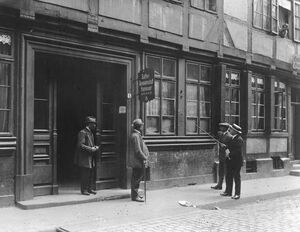
Haarmann's apartment.
Haarmann's last murdered victim was 17-year-old Erich de Vries; at this time, police had begun an enormous manhunt for the serial killer. Suspicion quickly fell on him due to knowledge of his 1898 molestation crimes and the disappearance of Friedel Rothe years ago. Police silently observed Haarmann, and on June 22, they apprehended him after he attempted to lure in a would-be victim, Karl Fromm, from Hanover's central station; Fromm had spent several days in Haarmann's apartment before, during which he was sexually assaulted by him. Haarmann would later confess to his intention of killing Fromm, marking the first time that he was guided by moral principles, although it ironically proved to be his downfall. Police searched Haarmann's home and found the walls sporting bloodstains, with Haarmann alleging it to be an unhandy result of the illegal meat-trade business he ran there. However, officers found clothing and belongings of his victims and arrested him on suspicion of the Hanover murders. Haarmann quickly confessed to being the perpetrator and claimed that the number of lives he took ranged from "somewhere between 50 and 70", though police made it official that the true body count was measured to 24-27 victims. He then aided officers in finding undiscovered parts of his victims and the dumpsites at the Leine River. He proved overall to become extremely cooperative in the investigation, save for instances in which he was confronted by families of his victims or conversing about decapitation, to which he would become withdrawn.
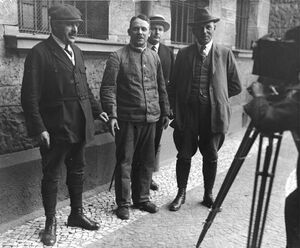
Haarmann (middle) with police detectives.
Haarmann's trial began on December 4, 1924, and was conducted at the Hannover Assizes. As the term "serial killer" had not been coined yet, there were no words to describe Haarmann other than "werewolf" or "vampire". Hoping to take Grans with him to execution, he resorted to accusing him of some of the murders, which the court actually came to believe. A notable aspect of the case was the shock that came to the public after the discovery that Haarmann was a police informant, and therefore, the police never came to suspect him of the murders even though witnesses pointed him out as being with his last victims. Haarmann's trial lasted for two weeks and required 200 witnesses to explain their accounts. He was found guilty of murdering all but three of the victims tied to him and sentenced to death by guillotine. On April 15, 1925, he was beheaded by guillotine, but not before he said as his last words, "I repent, but I do not fear death." The remains of his victims were buried together in a grave at Stöckener Cemetery months before his execution, with a large, granite, triptych-style memorial inscribed with the victims' names and ages being erected on April 1928. Haarmann's head was preserved in a jar by scientists, who used it in their studies to examine the structure of his brain. It was being kept at the Göttingen medical school until 2014 when it was cremated.
Hans Grans[]
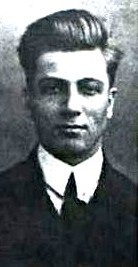
Hans Grans.
Hans Grans spent his early years as a petty thief before running away from his home, making his living by selling old clothes. He soon met Fritz Haarmann at Hanover's central station after offering to prostitute himself in exchange for money. The two soon became friends, and then lovers. From March 1920 to December of the same year, Grans traveled through Germany, committing petty robberies before returning to Hanover and reuniting with Haarmann on Christmas, later moving into a new apartment, number 27 Cellerstraße, with him. On February 12, 1923, he returned home unexpectedly to find Haarmann murdering his second victim, 17-year-old Fritz Franke. Condoning the act, he soon became Haarmann's accomplice and live-in partner. Grans even chose two of Haarmann's victims for him, one of them 17-year-old Adolf Hannappel, who was murdered on November 11, 1923. Grans was arrested on July 8, 1924, and initially found guilty to enticement to the murder of Hannappel. Haarmann and eyewitnesses verified that Grans picked Hannappel out for the former and as a result, Grans was sentenced to death. However, he was cleared and the sentence was reduced after a letter written by Haarmann that declared Grans's innocence was discovered. Instead, Grans served twelve years in prison and was eventually released. He continued to live in Hanover until his death in 1975, from natural causes.
Modus Operandi[]
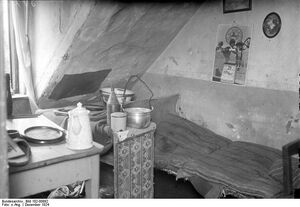
Haarmann's apartment, where his victims were likely killed.
"I'd make two cuts in the abdomen and put the intestines in a bucket, then soak up the blood and crush the bones until the shoulders broke. Now I could get the heart, lungs and kidneys and chop them up and put them in my bucket. I'd take the flesh off the bones and put it in my waxcloth bag. It would take me five or six trips to take everything and throw it down the toilet or into the river. I always hated doing this, but I couldn't help it — my passion was so much stronger than the horror of the cutting and chopping."
Haarmann usually targeted young male commuters and runaways, but also occasionally killed male prostitutes. He found all of his victims hanging around at Hanover's central station. Luring them into his apartment, Haarmann would offer them food or drinks, then kill them by biting through their throats (which he referred to as his "love bites"); some of the victims had their blood drank and were also sodomized. The victims would then be dismembered, with the parts being discarded at the Leine River (with the exception of his first victim, whose body was buried in a cemetery), while their possessions were either sold on the black market or kept by Haarmann and Grans.
Known Victims[]
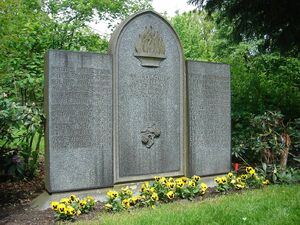
The Stöckener Cemetery memorial for Haarmann's victims
Note: The dates denote when the victims disappeared.
- Unspecified dates: Numerous petty burglaries and con jobs
- c. 1898: An unspecified amount of unnamed children (all were molested only)
- Unspecified date in 1898-1918: Ollie Haarmann (his father; assaulted)
- 1918:
- September: Hermann Koch, 14 (possibly; disappeared weeks prior to Friedel Rothe; the charges were dropped)
- September 25: Friedel Rothe, 17
- March 17, 1922: Hans Keimes, 17 (possibly; was strangled; a handkerchief bearing Grans's name was found lodged in his throat)
- 1923:
- February 12: Fritz Franke, 17
- March 20: Wilhelm Schulze, 17
- May 23: Roland Huch, 16
- c. May 31: Hans Sonnenfeld, 19 (was acquitted of his murder)
- June 25: Ernst Ehrenberg, 13
- August 24: Heinrich Struß, 18
- September 24: Paul Bronischewski, 17
- c. September 30: Richard Gräf, 17
- October 12: Wilhelm Erdner, 16
- October 24-25: Hermann Wolf, 15 (was acquitted of his murder)
- October 27: Heinz Brinkmann, 13
- November 11: Adolf Hannappel, 17
- December 6: Adolf Hennies, 19 (was acquitted of his murder)
- 1924:
- January 5: Ernst Spiecker, 17
- January 15: Heinrich Koch, 20
- February 2: Willi Senger, 19
- February 8: Hermann Speichert, 16
- April 6: Alfred Hogrefe, 16
- c. April 15: Hermann Bock, 22
- April 17: Wilhelm Apel, 16
- April 26: Robert Witzel, 18
- May 9: Heinrich Martin, 14
- May 26:
- Fritz Wittig, 17
- Friedrich Abeling, 10
- June 5: Friedrich Koch, 16
- June 14: Erich de Vries, 17
- June 22: Karl Fromm, 15 (sexually assaulted and later attempted to kill)
Legacy[]
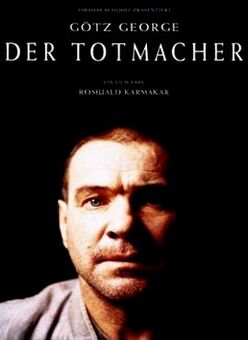
Der Totmacher poster.
In the wake of his killings, Haarmann has inspired three films to date. The first, a 1931 German drama-thriller named M, is well-known and has also been inspired by two other serial killers, Peter Kürten and Carl Großmann. The second, The Tenderness of the Wolves (Die Zärtlichkeit der Wölfe), was released on July 1973 and is directly based upon Haarmann's murders. And finally, the most recent is Der Totmacher (The Deathmaker), which was released on 1995 and, like the previous film, is based on Haarmann's murders. Haarmann has also been mentioned in several novels, a subject of focus in a song called "Fritz Haarmann [sic] der Metzger" ("Fritz Haarmann the butcher") by the band Macabre, and has even been used as a company logo for Beton Kopf Media, a record label.
On Criminal Minds[]
- Season Three
- "Lucky" - While not directly mentioned or referenced in this episode, Haarmann appears to have been an inspiration for the episode's unsub, Floyd Feylinn Ferell - Both were prolific and cannibalistic serial killers who committed crimes against minors before their murders (Haarmann molested numerous children, while Ferell attacked his younger sister), were also institutionalized prior to their murders, targeted both prostitutes of a certain gender (males in Haarmann's case, females in Ferell's) and others, killed them by ripping open their throats in some way (Haarmann bit open his in what he called "love bites", while Ferell simply slashed with a blade), dismembered their victims post-mortem and (possibly in Haarmann's case) fed them as meat to unwitting customers. Also Ferell having Manning as a patsy is somewhat similar to Haarmann having Hans Grans as an accomplice. Ferell also appears in Season Thirteen.
- Season Eight
- "Magnum Opus" - Haarmann was mentioned when the BAU compared his sloppy method of drawing blood from his victims (by biting) with that of the prominent unsub, Bryan Hughes, who may have been based on him - Both were serial killers who lured their victims to their homes with ruses (though Hughes also abducted victims through force alone) and collected their blood in some way while killing them.
- Season Nine
- "The Inspiration" and "The Inspired" - While not directly mentioned or referenced in the two-part season premier, Haarmann appears to have been an inspiration for Wallace Hines - Both were serial killers who had siblings, were institutionalized before their killings, primarily targeted one gender (male teens and young men in Haarmann's case, women in Hines', though he also killed men), dismembered their victim's bodies post-mortem, and fed their remains to others (though Haarmann is only suspected of doing this).
- Season Thirteen
- "Bad Moon on the Rise" - While not directly mentioned or referenced in this epiosde, Haarmann appears to have been an inspiration for the episode's unsub, Mitchell McCord - Both were psychotic serial killers who were in relationships with women who later rejected them (McCord's wife decided to divorce him following the death of their son, while Haarmann's fiancée left him when he accused her of having an affair), targeted men, killed their victims by biting into their throats, performed post-mortem rituals on their victims' bodies, sometimes involving their mouths (McCord bit off two fingers of one victim, Haarmann sometimes drank his victims' blood), stole personal items from their victims, and were given names involving werewolves by the media for their crimes.
